Chapter 5: Beekeeper Co-operative Societies of Uttara Kannada
5.1. Introduction
Three-fourth of the India’s population lives in rural India and 70 percent of them depend on agriculture and its allied activities. One of the very important factors to increase the agricultural productivity is beekeeping. Mahatma Gandhi, realize importance of healthy village economy tried to promote bee keeping. Training programmes for bee keeping were conducted in his ashram itself. After independence, Khadi and Village Industries Commission was constituted in 1956, This Commission played a crucial role in the strengthening of rural economy by promoting and developing beekeeping and other cottage industries. An extensive network of State Khadi and Village Industries Boards, Bee-keeping Cooperative Societies and registered Institutions were established in the country.
Beekeeping provides honey, a nourishing food and medicine, and various other valuable products like wax, pollen, bee venom, propolis and royal jelly. It has been estimated that bee-keeping in the world is being carried out in an estimated four crore colonies. The United States, USSR, and China together account for about 50% of the bee colonies and remaining are found in other countries. Few decades ago, China had 60, 00,000 bee colonies. Now that number has exceeded one crore colonies, overtaking India, and is targeting a phenomenal increase to five crore colonies in the next few decades. To achieve this target China has taken on afforestation mission on a large scale, including road-side plantings and other programmes to increase bee-flora and creating timber for production of bee boxes. All these bee colonies, besides honey production, are regularly used for planned bee-pollination of various cross-fertile crops, thereby improving the crop yields both, qualitatively and quantitatively (Phadke, 2008).
In Uttara Kannada the beekeeping activities have been promoted jointly by Khadi and Village Industries Commission (KVIC) and the National Horticulture Mission through beekeepers co-operative societies. The Honavar Beekeepers Co-operative Society, the first in Uttara Kannada district, was started in 1941. Four more such societies were established at Kumta, Ankola, Sirsi-Yellapur and Siddapur (Karnataka state Gazetteer of Uttara Kannada, 1985; Prabhakar and Milind, 2011). Although the massive potential of honey production exists in the hilly taluks like Yellapur, Sirsi and Siddapur, the Sirsi-Yellapur society had gone almost defunct. The present study aims at an appraisal of the performance of the beekeepers co-operative societies in the district with regard to promotion of beekeeping, honey procurement, and constrains for the growth of such societies in Uttara Kannada district.
5.2. Materials and methods
Uttara Kannada district is situated in the north-west part of Karnataka State, between longitude 74o 9’ to 75o 10’E and latitude 13o 55’ to 15o 31’N. The district has a geographical area of 10,327 sq. km, and is bordered by the Belgaum district and Goa State to the north, Dharwad in the east, Shimoga and Udupi districts towards south-east and south respectively and the Arabian Sea to the west. The district has three distinctive zones such as coastal zone, hill zone and eastern transitional zone. These zones are currently divided into 11 taluks, of which Ankola, Bhatkal, Honavar, Karwar and Kumta make the coastal zone, Siddapur, Sirsi, Supa and Yellapur make the hill zone and the relatively flatter Haliyal and Mundgod make the transitional zone. Relief and climate have introduced these regional differences. The present study was carried out covering the performance of beekeepers co-operative societies in four taluks (Ankola, Kumta, Honavar and Siddapur) of Uttara Kannada (figure 5.1 for study area map).
We collected last 11 years data (2001-11) from these four beekeepers societies and additionally interviewed secretaries of the societies regarding growth in membership, trends in honey production, problems of beekeeping and training programmes being arranged by the societies. The data was entered and tabulated in the Microsoft excel sheets. Data analysis was done to find out the trends in honey procurements, society memberships and to find out the causes for malfunctioning of the societies if any.
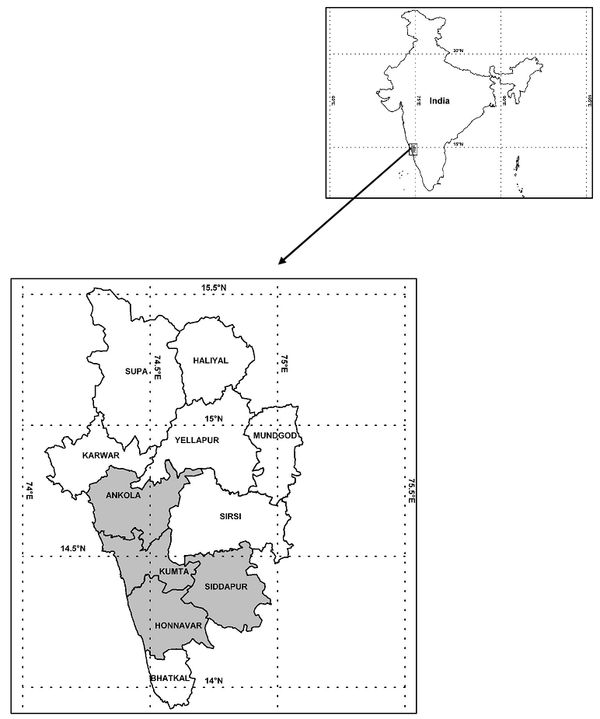
Figure 5.1: The map of Uttara Kannada with the study taluks shaded
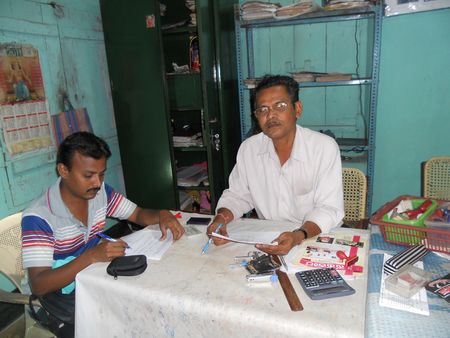
Plate 5.1: Data collection at beekeepers co-operative society at Ankola
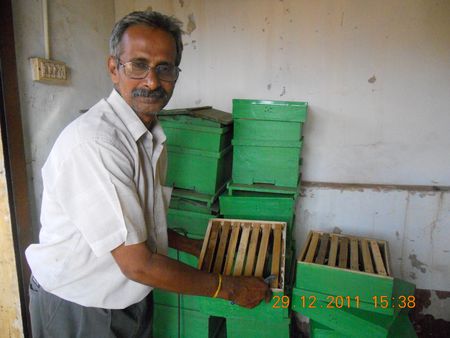
Plate 5.2: Shridhar Hegde of beekeepers co-operative society at Honavar showing bee keeping equipments
5.3. Results and discussion:
Honavar society had the highest number of members (992) in 2011, and Ankola society had the lowest (204). A glance through the growth in membership over the past 11 years of all these societies reveal only stunted growth (Table: 5.1 and Figure: 5.2). The Honavar society showed even a decline in membership from 1148 in 2002 to 992 in 2011. The beekeeper societies, although constituted with good objectives of promoting beekeeping as on important enterprise in Uttara Kannada have entered a stagnant phase due to the following reasons:
- The honey procurement prices of the societies are lower than the open market values, which prompts the producers to sell honey in the open markets. For e.g. whereas the producers get a price for Rs.250 to Rs.300/kg of mixed honey in the open market, the society procurement prices range from Rs.140/- to Rs.180/- only. For soapnut honey the market pays a handsome price of Rs.1000/- or more whereas the Honavar society’s procurement price in 2011 was about Rs.500 – Rs.550/kg only and its selling price was about Rs.700/kg. from which the producer does not get any share.
- The beekeepers society’s records regarding procurement of honey do not reflect the real situation regarding actual number of producers in the jurisdiction of respective societies, apart from the members, the quantities produced, potential production etc. The societies’ major sources of honey seem to be from the forest contractors who gather wild honey. Some societies even get litchi honey from states like Bihar and Uttara Pradesh at much cheaper rates, not exceeding Rs. 90/ kg, and blend with local honey, and market the mix (Honavar Bee-keeper’s Society and Kadamba Marketing Souhardha Sahakar Ltd., Sirsi – personal communication).
- The beekeeping equipments are not readily available from the societies to the members. The members many times are required to make repeated visits to get the equipments especially from Sirsi and Kumta taluk societies. Such equipments and accessories are more readily available from private sources (such as for e.g. from Dharmendra Hegde, Kangod, Balachandra Hedge, Salkani etc. - both in Sirsi) who are themselves good beekeepers. They as well sell bee colonies along with the boxes and other accessories. Kumta and Sirsi-Yellapur societies have almost gone into dormant states. Honavar, Ankola and Siddapur societies fare better.
Table 5.1: Membership of beekeepers in the beekeepers co-operative societies during 2001 to 2011.
| Year |
Ankola |
Kumta |
Honavar |
Siddapur |
| 2001 |
155 |
391 |
1100 |
334 |
| 2002 |
156 |
391 |
1148 |
337 |
| 2003 |
166 |
391 |
1145 |
342 |
| 2004 |
172 |
391 |
889 |
343 |
| 2005 |
178 |
391 |
926 |
345 |
| 2006 |
180 |
391 |
942 |
349 |
| 2007 |
180 |
391 |
950 |
349 |
| 2008 |
188 |
391 |
956 |
355 |
| 2009 |
195 |
391 |
965 |
355 |
| 2010 |
197 |
392 |
972 |
359 |
| 2011 |
204 |
393 |
992 |
378 |
Table 5.2: Quantity of soapnut honey procured by four beekeepers co-operative societies during 2001 – 2011.
| Year |
Qty. of soapnut honey procured |
| Ankola |
Kumta |
Honavar |
Siddapur |
| 2001 |
106 |
12 |
0 |
0 |
| 2002 |
120 |
0 |
0 |
0 |
| 2003 |
156 |
0 |
0 |
0 |
| 2004 |
350 |
2 |
0 |
0 |
| 2005 |
282 |
0 |
0 |
0 |
| 2006 |
120 |
20 |
0 |
0 |
| 2007 |
80 |
15 |
0 |
0 |
| 2008 |
86 |
3 |
0 |
0 |
| 2009 |
83 |
68 |
230 |
0 |
| 2010 |
52 |
4 |
250 |
0 |
| 2011 |
21 |
0 |
135 |
0 |
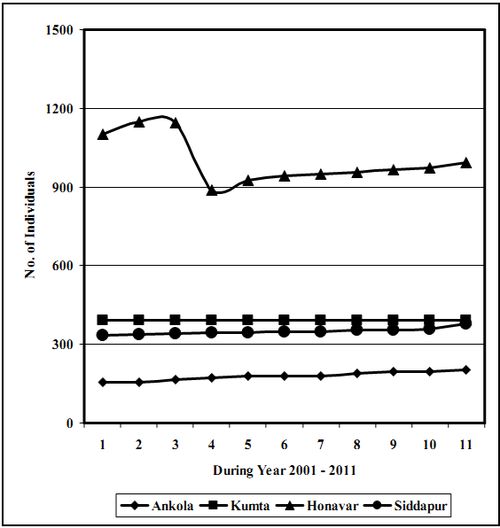
Figure 5.2: Membership in the beekeepers co-operative societies during 2001 to 2011.
Soapnut honey procured by societies
Honey from the soapnut tree (Sapindus laurifolius) is by far the most expensive honey. Soapnut trees flower during November-December period, before most other bee-forage trees flower. Therefore soapnut honey is often unmixed; attributed with medicinal values and fetches handsome rates to the producers. Soapnut trees are more characteristic of the coastal forests and homesteads than the interior places of the district. Therefore soapnut honey production is mostly from the coastal areas of Uttara Kannada. All the soapnut honey being currently procured by the societies is mainly from the coastal taluks (Table.5.2). The quantities procured by the societies are not much and are showing declining trend (Eg. Ankola, Kumta and Honavar societies). In the Honavar society separate record keeping on soapnut honey procurement commenced only in 2009. Although soapnut is a tree that can be easily grown on a variety of soils, including in open areas and on roadsides, with little care, and considering that the fruit is economically valued, and the tree becomes a good cover for barren areas, very little efforts were made hitherto to plant these trees in large scale by the Forest Department or by private landowners.
Production and sale of non-soapnut or mixed honey
The procurement figures of non-soapnut honey, including mixed honey, by the four societies (Table 5.3) scrutinized for the period 2001-2011 shows that the role of societies in the overall honey trade is diminishing. The performances of all the societies, barring Siddapur, have reached the lowest ever during 2010-2011 periods. The Siddapur Society’s records of procurement prior to 2005 were not available. The higher procurement in Honavar during 2004-08 periods is an exception. The rising demand for honey in the open market prompts the producers to sell their products directly to the consumers without the intervention of the societies. It may be concluded that these societies are mere shadows of their past and cannot justify their existence any further as procurers or traders of honey and their roles in promoting beekeeping need to be redefined; for e.g., role in creation of awareness and training programmes on bee keeping and supply of equipments to the bee keepers etc.
Table 5.3: Quantity of honey (other than soapnut) procured by beekeepers co-operative societies during 2001 – 11.
| Year |
Qty. of non-soapnut honey procured (kg) |
| Ankola |
Kumta |
Honavar |
Siddapur |
| 2001 |
2610 |
963 |
3152 |
NA |
| 2002 |
1330 |
208 |
4635 |
NA |
| 2003 |
1096 |
66 |
4610 |
NA |
| 2004 |
2100 |
128 |
9388 |
NA |
| 2005 |
3136 |
163 |
6969 |
3782 |
| 2006 |
2010 |
186 |
10019 |
423 |
| 2007 |
1121 |
250 |
11470 |
2422 |
| 2008 |
950 |
70 |
8291 |
1011 |
| 2009 |
1091 |
264 |
3653 |
5867 |
| 2010 |
1040 |
101 |
965 |
354 |
| 2011 |
1200 |
178 |
475 |
3068 |
NA = Data not available
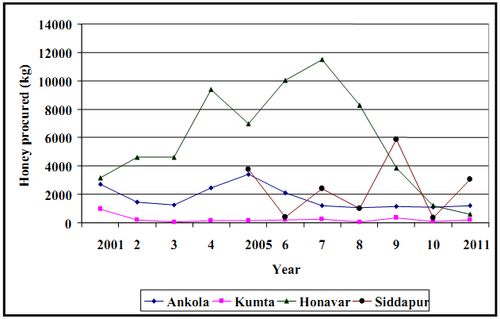
Figure 5.3: Trends in honey procurement by beekeepers co-operative societies for 2001-11
Total quantity of honey procured by four societies
In figure 5.3 are shown the total quantity of honey (soapnut + non-soapnut) procured by the four societies concerned during the 2001-2011 period. The figures depict the uncertainties in the performance of the bee-keeper’s societies examined. The societies had played key roles in the past highlighting the importance of bee keeping as an income generating rural enterprise and assisted the village communities to start these ventures by providing equipments, subsidies and technical consultancy. The societies also helped the producers in marketing honey. The growth of the open market with phenomenal prices offered to the producers has sidelined the importance of these societies.
5.4. Prescriptions for future
It is amply evident the bee-keeper societies of the district are not performing well in their prime task of procuring and selling honey. On the contrary more honey is sold in the market at good prices directly by the producers. In this changed scenario it is time to redefine the role of these societies in the field of be-keeping.
Honey is a precious plant product with ever increasing market demand. It is not only useful as a tasty food but also is rich in nutrients and is very useful for medicines and confectionary. The bee-keeper’s societies played a historical role in Uttara Kannada district in popularizing bee-keeping as an important rural enterprise so as to generate family income and to reduce the intensity of honey collection from the wild which is more destructive to the bee colonies. The method of domestication of bees and extraction of honey scientifically using simple equipments were popularized through training programmes. Today the bee-keeping has grown beyond the domain of the societies. It is growing independently, more in a disorganized fashion. Although the potential of bee-keeping in Uttara Kannada, a well forested and horticulturally important district, is tremendous, the potential is hardly ever realized due to the lack of co-ordinated approach. In a free market economy, with ever increasing demand for honey from local markets and cities, the bee-keeper’s societies, instead of going redundant, can play important role in systematically nurturing bee-keeping through awareness creation and training programmes, foster the growth of bee forage plants and pave way for creation of employment for thousands of rural people.
Private bee-keepers in the district are not often a trained lot. Whereas some have got good mastery on the field and are good entrepreneurs and trainers, most others have performance below par, due to lack of proper training. In the early days of the societies there used to be expert trainers with them visiting villages to guide the bee keepers in scientific methods and even used to take care of the spread of bee diseases through control measures. The societies are today not able to grapple with open market system and are weakening in their performance. Instead of simply functioning as honey procurement centres at tardy prices they can concentrate on the conduct of training programmes and create awareness of beekeeping and importance of pollination crop productivity.